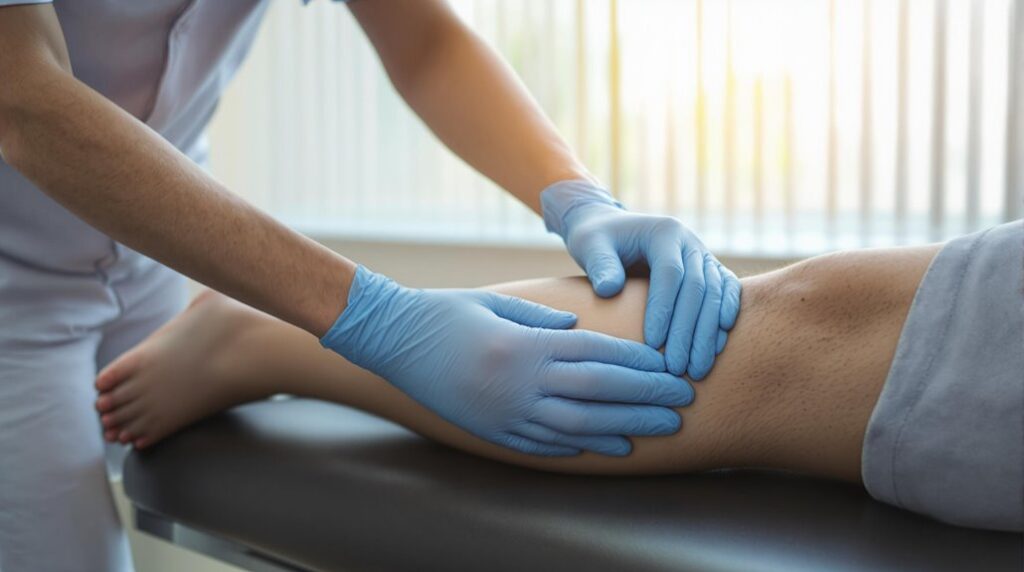You'll accelerate sports injury recovery with these five manual therapy techniques: Active Release Technique breaks up scar tissue through targeted movement, while Cross-Fiber Friction Massage increases blood flow to damaged areas. Trigger Point Release alleviates muscle knots using sustained or intermittent pressure, and Joint Mobilization addresses restricted skeletal movement. Myofascial Release targets connective tissue with sustained pressure. Understanding these methods in detail can transform your approach to injury rehabilitation.
Active Release Technique for Muscle Recovery
While athletes have long relied on traditional massage techniques, Active Release Technique (ART) has emerged as a groundbreaking approach to treating sports-related soft tissue injuries. You'll find that ART practitioners use their hands to evaluate the texture, tightness, and movement of muscles, fascia, tendons, and ligaments. During treatment, you'll need to actively move the affected body part through specific movements while the practitioner applies precisely directed tension.
You can expect ART to break up scar tissue and adhesions that have formed due to acute injuries or repetitive motions. The technique's proven particularly effective for conditions like tennis elbow, runner's knee, and shoulder impingement. You'll typically notice improved range of motion and decreased pain after just a few sessions, though chronic conditions may require more extensive treatment. Incorporating soft tissue therapy into your recovery plan can further enhance the benefits of ART, ensuring a more comprehensive approach to healing.
Cross-Fiber Friction Massage Benefits
Cross-fiber friction massage represents another specialized manual therapy technique that targets specific tissue damage at a deeper level than traditional massage methods. You'll find this approach particularly effective for addressing scar tissue, adhesions, and chronic soft tissue injuries that haven't responded well to other treatments.
When you receive cross-fiber friction massage, the therapist will apply pressure perpendicular to your muscle or tendon fibers, which helps break down restrictive tissue and stimulate healing. You'll notice this technique can increase your local blood flow, reduce inflammation, and promote the formation of more flexible scar tissue. The benefits you'll experience include improved range of motion, decreased pain levels, and faster recovery from sports-related injuries. It's especially useful for conditions like tennis elbow, runner's knee, and various tendinopathies. Additionally, this method aligns with the goal of preventing future injuries, as it enhances tissue health and resilience.
Trigger Point Release Methods
As you explore various manual therapy techniques, trigger point release methods stand out as vital tools for addressing localized muscle tension and pain. You'll find two primary approaches: sustained pressure and intermittent pressure release. To perform sustained pressure, you'll need to apply firm, steady compression to the trigger point for 30-60 seconds, allowing the tissue to gradually release. For intermittent pressure, you'll alternate between applying and releasing pressure every few seconds.
When you're working with trigger points, it's important to identify the correct location through palpation and client feedback. You can enhance the effectiveness by incorporating active range of motion exercises during or after the release. Remember to adjust the pressure based on tissue response and client tolerance, as excessive force can be counterproductive. Additionally, employing techniques such as sports massage can further aid in enhancing recovery and performance.
Joint Mobilization Strategies
Joint mobilization expands the scope of manual therapy beyond soft tissue work to address restricted movement in the skeletal system. You'll need to assess joint mobility carefully before applying oscillating movements or glides to restore normal joint mechanics. When performing these techniques, you'll want to focus on the joint's physiological barrier while maintaining patient comfort.
Start with grade I and II mobilizations for pain management, then progress to grades III and IV to increase range of motion. You can apply these techniques to various joints, including the ankle, knee, and shoulder, using specific directional movements that match the joint's natural planes of motion. Remember to reassess the joint's mobility after each intervention, and you'll need to modify your approach based on the patient's response and tissue tolerance. Effective rehabilitation strategies are essential for optimizing recovery from sports injuries.
Myofascial Release Applications
When treating sports injuries, myofascial release techniques target the body's connective tissue system through sustained pressure and specific movement patterns. You'll need to apply gentle, sustained pressure to identified trigger points or restricted fascia for 3-5 minutes until you feel the tissue release. During application, you can use various tools like foam rollers, massage balls, or your hands to effectively address different body areas.
To maximize results, you'll want to focus on both the primary injury site and connected tissue chains, as restrictions often occur along fascial lines. You can identify problematic areas by looking for tissue that feels rigid, tender, or rope-like under palpation. Remember to work within your client's comfort level, as excessive pressure can trigger protective muscle guarding and counteract the treatment's benefits.

